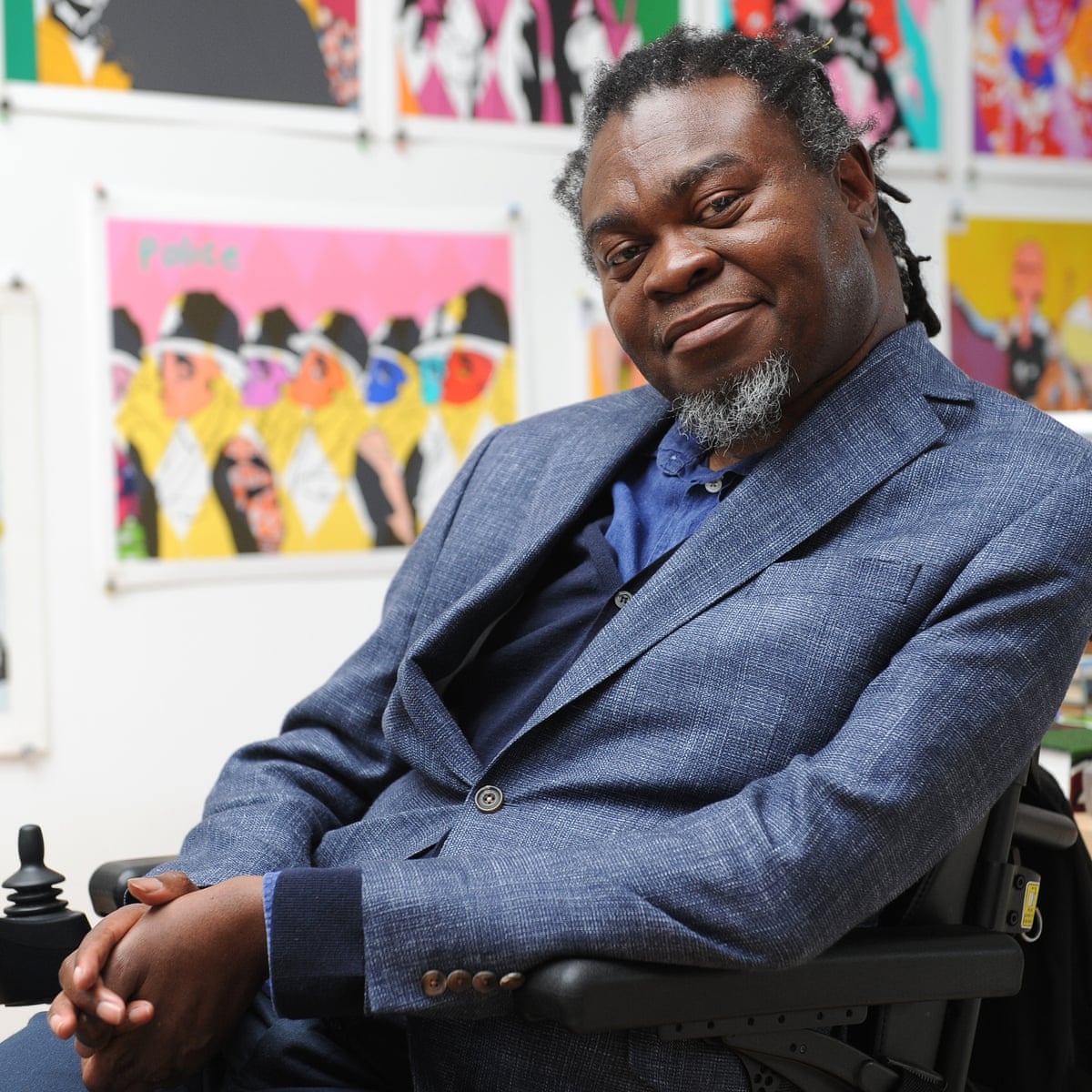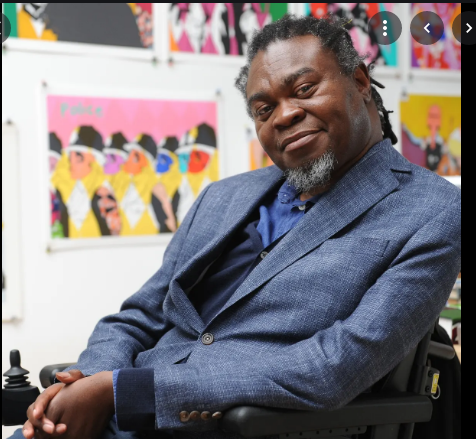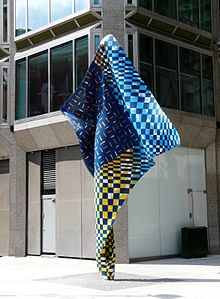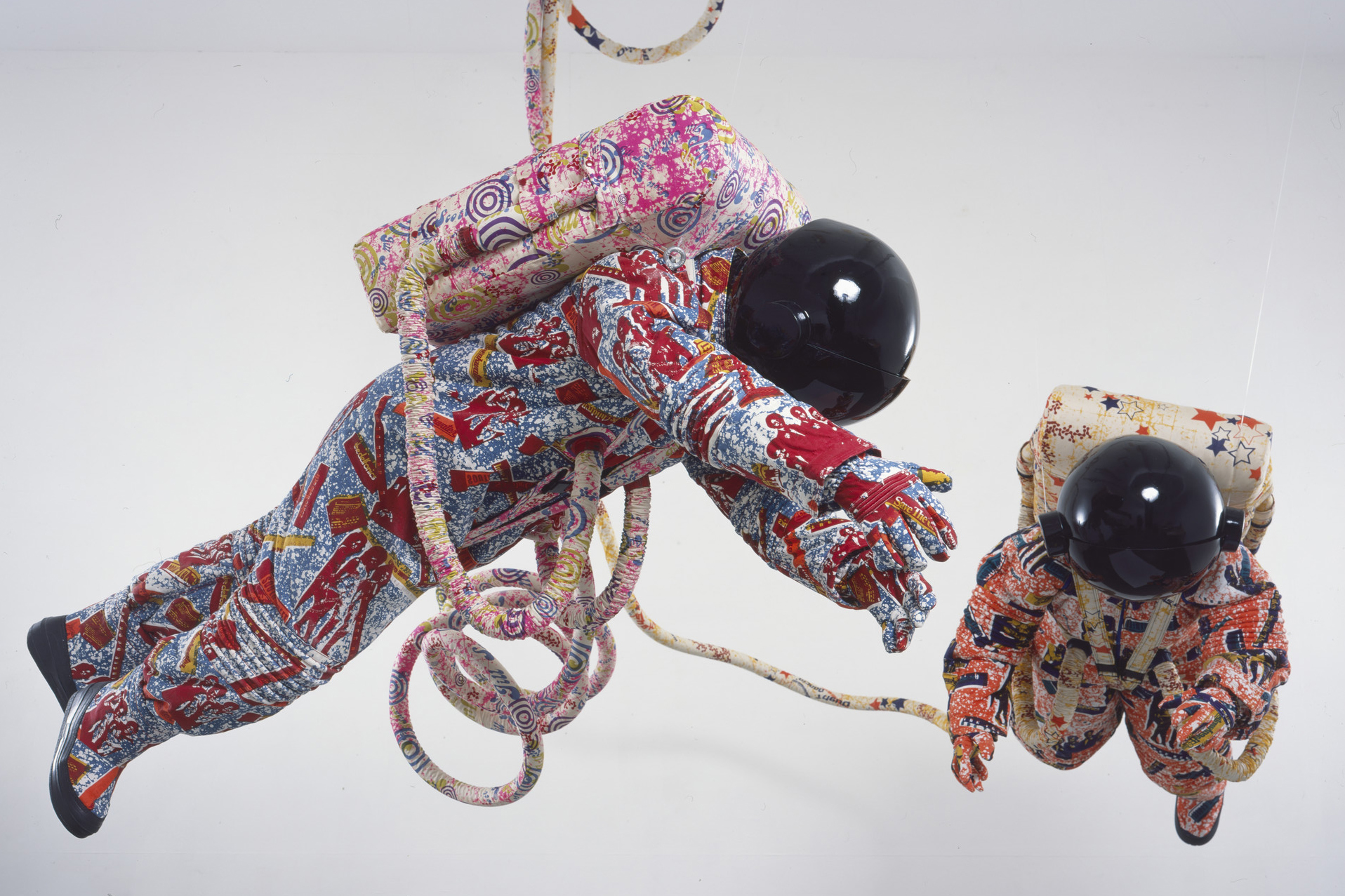 Yinka Shonibare CBE, RA (born 9 August 1962) is a British-Nigerian artist living in the United Kingdom. His work explores cultural identity, colonialism and post-colonialism within the contemporary context of globalisation. A hallmark of his art is the brightly coloured Ankara fabric he uses. Because he has a physical disability that paralyses one side of his body, Shonibare uses assistants to make works under his direction.
Yinka Shonibare CBE, RA (born 9 August 1962) is a British-Nigerian artist living in the United Kingdom. His work explores cultural identity, colonialism and post-colonialism within the contemporary context of globalisation. A hallmark of his art is the brightly coloured Ankara fabric he uses. Because he has a physical disability that paralyses one side of his body, Shonibare uses assistants to make works under his direction.
Life and career
Yinka Shonibare was born in London, England, on 9 August 1962, the son of Olatunji Shonibare and Laide Shonibare. When he was three years old, his family moved to Lagos, Nigeria, where his father practised law. When he was 17 years old, Shonibare returned to Britain to do his A-levels at Redrice School. At the age of 18, he contracted transverse myelitis, an inflammation of the spinal cord, which resulted in a long-term physical disability where one side of his body is paralysed. Shonibare went on to study Fine Art first at Byam Shaw School of Art (now Central Saint Martins College of Art and Design) and then at Goldsmiths, University of London, where he received his MFA degree, graduating as part of the Young British Artists generation. Following his studies, Shonibare worked as an arts development officer for Shape Arts, an organisation that makes arts accessible to people with disabilities.
He has exhibited at the Venice Biennial and at leading museums worldwide. He was notably commissioned by Okwui Enwezor at documenta XI in 2002 to create his most recognised work Gallantry and Criminal Conversation that launched him on an international stage.
In 2004, he was shortlisted for the Turner Prize for his Double Dutch exhibition at the Museum Boijmans van Beuningen in Rotterdam and for his solo show at the Stephen Friedman Gallery, London. Of the four nominees, he seemed to be the most popular with the general public that year. A BBC website poll, resulted in 64% of voters stating that his work was their favourite.
 Shonibare became an Honorary Fellow of Goldsmiths’ College in 2003, was awarded an MBE in 2004, received an Honorary Doctorate (Fine Artist) of the Royal College of Art in 2010 and was appointed a CBE in 2019. He was elected Royal Academician by the Royal Academy of Arts in 2013. He joined Iniva‘s Board of trustees in 2009.[13] He has exhibited at the Venice Biennial and internationally at leading museums worldwide. In September 2008, his major mid-career survey commenced at the MCA Sydney and toured to the Brooklyn Museum, New York, in June 2009 and the National Museum of African Art of the Smithsonian Institution, Washington DC, in October 2009. In 2010, Nelson’s Ship in a Bottle became his first public art commission on the Fourth Plinth in Trafalgar Square.
Shonibare became an Honorary Fellow of Goldsmiths’ College in 2003, was awarded an MBE in 2004, received an Honorary Doctorate (Fine Artist) of the Royal College of Art in 2010 and was appointed a CBE in 2019. He was elected Royal Academician by the Royal Academy of Arts in 2013. He joined Iniva‘s Board of trustees in 2009.[13] He has exhibited at the Venice Biennial and internationally at leading museums worldwide. In September 2008, his major mid-career survey commenced at the MCA Sydney and toured to the Brooklyn Museum, New York, in June 2009 and the National Museum of African Art of the Smithsonian Institution, Washington DC, in October 2009. In 2010, Nelson’s Ship in a Bottle became his first public art commission on the Fourth Plinth in Trafalgar Square.
On 3 December 2016, one of Shonibare’s “Wind Sculpture” pieces was installed in front of the Smithsonian’s National Museum of African Art (NMAA) in Washington, DC. The painted fibreglass work, titled “Wind Sculpture VII”, is the first sculpture to be permanently installed outside the NMAA’s entrance.
He runs Guest Projects, a project space for emerging artists based in Broadway Market, east London. He is extending this to spaces in Lagos and Nigeria.
Work
Shonibare’s work explores issues of colonialism alongside those of race and class, through a range of media which include painting, sculpture, photography, installation art, and, more recently, film and performance. He examines, in particular, the construction of identity and tangled interrelationship between Africa and Europe and their respective economic and political histories. Mining Western art history and literature, he asks what constitutes our collective contemporary identity today. Having described himself as a “post-colonial” hybrid, Shonibare questions the meaning of cultural and national definitions. While he often makes work inspired by his own life and experiences around him, he takes inspiration from around the world as he said “I’m a citizen of the world, I watch television so I make work about these things”.[18]
A key material in Shonibare’s work since 1994 is the brightly coloured “African” fabric (Dutch wax-printed cotton) that he buys himself from Brixton market in London. “But actually, the fabrics are not really authentically African the way people think,” says Shonibare. “They prove to have a crossbred cultural background quite of their own. And it’s the fallacy of that signification that I like. It’s the way I view culture – it’s an artificial construct.” Shonibare claims that the fabrics were first manufactured in Europe to sell in Indonesian markets and then they were sold in Africa, when they were rejected in Indonesia. Today the main exporters of “African” fabric from Europe are based in Manchester in the UK and Vlisco Véritable Hollandais from Helmond in the Netherlands. Despite being a European invention, many Africans in England like Shonibare use the Dutch wax fabric. He has these fabrics made up into European 18th-century dresses, covering sculptures of alien figures or stretched onto canvases and thickly painted over.
Shonibare is well known for creating headless, life-size sculptural figures meticulously positioned and dressed in vibrant wax cloth patterns in order for history and racial identity to be made complex and difficult to read.[21] In 2003, Shonibare reconstructs the Berlin Conference of 1884–1885 in Scramble for Africa when European leaders negotiated and arbitrarily divided the continent in order to claim African territories.[22] By exploring colonialism, particularly in this tableaux piece, the purpose of the headless figurines implies the loss of humanity as Shonibare explains: “I wanted to represent these European leaders as mindless in their hunger for what the Belgian King Leopold II called ‘a slice of this magnificent African cake.'” Scramble for Africa cannot be read as a ‘simple satire,’ but rather it reveals “the relationship between the artist and the work”. It is also an examination of how history tends to repeat itself. Shonibare states: “When I was making it I was really thinking about American imperialism and the need in the West for resources such as oil and how this pre-empts the annexation of different parts of the world.”
Shonibare’s Trumpet Boy, a permanent acquisition displayed at The Foundling Museum, demonstrates the colourful fabric used in his works. The sculpture was created to fit the theme of “found”, reflecting on the museum’s heritage,[26] through combining new and existing work with found objects kept for their significance.
Sometimes, he recreates famous paintings using headless dummies with the “Africanised” clothing instead of their original costumes, for example Gainsborough’s Mr and Mrs Andrews Without Their Heads (1998), Reverend on Ice (2005)(after The Rev Robert Walker Skating on Duddingston Loch by Raeburn) and The Swing (after Fragonard) (2001). An added layer to the Fragonard piece is that the fabric used is printed with the Chanel logo (though it is obviously not real Chanel fabric).
Shonibare also takes carefully posed photographs and videos recreating famous British paintings or stories from literature but with himself taking centre stage as an alternative, black British dandy, e.g., A Rake’s Progress by Hogarth which he translates into Diary of A Victorian Dandy (1998) or Dorian Gray (2001) after Oscar Wilde‘s novel The Picture of Dorian Gray.
Considerably larger than a usual ship in a bottle, yet much smaller than the real HMS Victory, in fact a 1:30-scale model, Shonibare’s Nelson‘s Ship in a Bottle, was “the first commission on the Fourth Plinth to reflect specifically on the historical symbolism of Trafalgar Square, which commemorates the Battle of Trafalgar, and will link directly with Nelson’s column.” The work was placed there on 24 May 2010 and remained until 30 January 2012. Being widely admired, in 2011 the Art Fund launched a campaign and successfully raised money for the purchase and relocation of the sculpture to the National Maritime Museum in Greenwich where it now found its new permanent home.
Other works include printed ceramics, and cloth-covered shoes, upholstery, walls and bowls.
In October 2013 Shonibare took part in Art Wars at the Saatchi Gallery curated by Ben Moore. The artist was issued with a stormtrooper helmet, which he transformed into a work of art. Proceeds went to the Missing Tom Fund set up by Ben Moore to find his brother Tom, who has been missing for more than ten years. The work was also shown on the Regent’s Park platform as part of Art Below Regents Park.
The Goodman Gallery announced in 2018 that the Norval Foundation, South Africa’s newest art museum based in Cape Town, has made a permanent acquisition of Shonibare’s Wind Sculpture (SG) III, making it the a first for the African continent. The sculpture will be unveiled in February 2019, increasing the British-Nigerian artist’s visibility on the continent where he grew up.
Shonibare has collaborated with Bellerby & Co, Globemakers.
Source: Wikipedia










